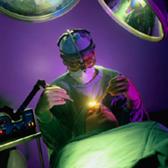|
  The highly collimated beam of a laser can be further focused to a microscopic dot of extremely high energy density. This makes it useful as a cutting and cauterizing instrument. The highly collimated beam of a laser can be further focused to a microscopic dot of extremely high energy density. This makes it useful as a cutting and cauterizing instrument.
Lasers have been used to make incisions half a micron wide, compared to about 80 microns for the diameter of a human hair.A focused laser can act as an extremely sharp scalpel for delicate surgery, cauterizing as it cuts. "Cauterizing" refers to long-standing medical practices of using a hot instrument or a high frequency electrical probe to singe the tissue around an incision, sealing off tiny blood vessels to stop bleeding. The cauterizing action is particularly important for surgical procedures in blood-rich tissue such as the liver. Because heat from lasers cauterizes blood vessels, there is less bleeding compared to scalpel use.
   Medical lasers have been used for dermatology applications such as removal of port wine stains, dark spots, tattoos, acne scars and other blemishes. Medical lasers have been used for dermatology applications such as removal of port wine stains, dark spots, tattoos, acne scars and other blemishes.
  Studies conducted by the manufacturers showed that the laser is as safe andeffective as ahigh-speed drill for removing dental decay and preparing a cavity for a filling. A manufacturer's study indicated that fewer patients needed anesthetic for pain. Lasers may be used to remove tissue in eye surgery as well. This may include removing tumors, cataracts, or proliferating blood vessels common to diabetic retinopathy.Higher power lasers are used after cataract surgery if the supportive membrane surrounding the implanted lens becomes milky. Photodisruption of the membrane often can cause it to draw back like a shade, almost instantly restoring vision.Lasers are used for photocoagulation of the retina to halt retinal hemorrhaging and for the tacking of retinal tears. Studies conducted by the manufacturers showed that the laser is as safe andeffective as ahigh-speed drill for removing dental decay and preparing a cavity for a filling. A manufacturer's study indicated that fewer patients needed anesthetic for pain. Lasers may be used to remove tissue in eye surgery as well. This may include removing tumors, cataracts, or proliferating blood vessels common to diabetic retinopathy.Higher power lasers are used after cataract surgery if the supportive membrane surrounding the implanted lens becomes milky. Photodisruption of the membrane often can cause it to draw back like a shade, almost instantly restoring vision.Lasers are used for photocoagulation of the retina to halt retinal hemorrhaging and for the tacking of retinal tears.
 Laser sight correction - Several manufacturers have lasers cleared for photorefractive keratectomy (PRK) and Laser-Assisted In Situ Keratomileusis (LASIK), two procedures for correcting nearsightedness, farsightedness, and astigmatism. The laser is used to reshape the cornea and focus images correctly on the retina.
(see your notes on sight defects). Laser sight correction - Several manufacturers have lasers cleared for photorefractive keratectomy (PRK) and Laser-Assisted In Situ Keratomileusis (LASIK), two procedures for correcting nearsightedness, farsightedness, and astigmatism. The laser is used to reshape the cornea and focus images correctly on the retina.
(see your notes on sight defects).
 Biostimulation lasers, are also called low level laser therapy (LLLT), cold lasers, soft lasers, or laser acupuncture devices. These devices are used for the temporary relief of pain. There are numerous clinical investigations being conducted to determine safety and efficacy with these devices for the intended uses that are proposed. – Biostimulation lasers, are also called low level laser therapy (LLLT), cold lasers, soft lasers, or laser acupuncture devices. These devices are used for the temporary relief of pain. There are numerous clinical investigations being conducted to determine safety and efficacy with these devices for the intended uses that are proposed. –
 Hair removal - Manufacturers may not claim that laser hair removal is either painless or permanent unless they provide sufficient data to demonstrate such results. Several manufacturers have received permission to claim, "permanent reduction," NOT "permanent removal" for their lasers. This means that although laser treatments with these devices will permanently reduce the total number of body hairs, they will not result in a permanent removal of all hair. The specific claim granted is "intended to effect stable, long-term, or permanent reduction" through selective targeting of melanin in hair follicles. Hair removal - Manufacturers may not claim that laser hair removal is either painless or permanent unless they provide sufficient data to demonstrate such results. Several manufacturers have received permission to claim, "permanent reduction," NOT "permanent removal" for their lasers. This means that although laser treatments with these devices will permanently reduce the total number of body hairs, they will not result in a permanent removal of all hair. The specific claim granted is "intended to effect stable, long-term, or permanent reduction" through selective targeting of melanin in hair follicles.
 Lasers are also being used to treat wrinkles. Several manufacturers have received clearance to claim treatment of wrinkles, while others may claim skin resurfacing. Patients have reported reddening of the skin, which lasted from one to four months. Pain was mild and could be treated with over-the-counter analgesics. People considering this procedure should consult a dermatologist or the manufacturer to determine whether or not they would be good candidates. Lasers are also being used to treat wrinkles. Several manufacturers have received clearance to claim treatment of wrinkles, while others may claim skin resurfacing. Patients have reported reddening of the skin, which lasted from one to four months. Pain was mild and could be treated with over-the-counter analgesics. People considering this procedure should consult a dermatologist or the manufacturer to determine whether or not they would be good candidates.
BBC News Report |
13 June 2011 |
 |
|
|




 L.A.S.E.R.s - Medical Applications
L.A.S.E.R.s - Medical Applications 





